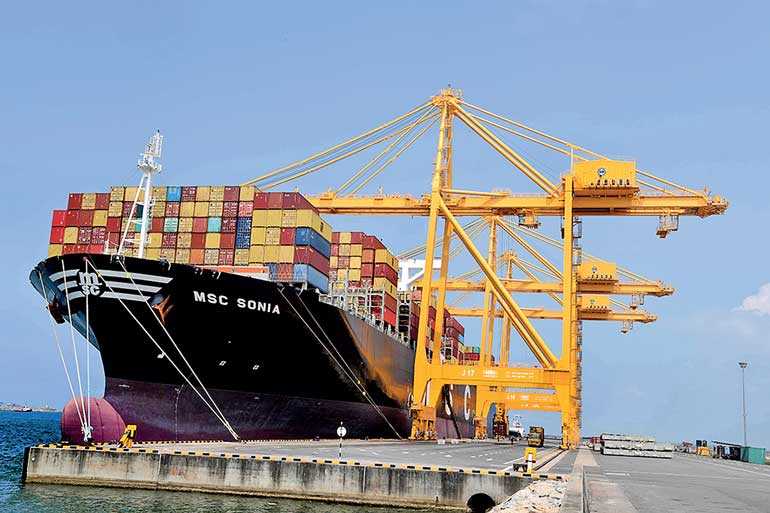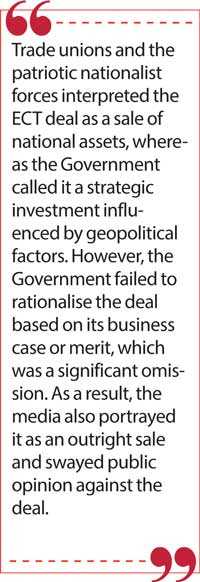Sunday Apr 20, 2025
Sunday Apr 20, 2025
Wednesday, 24 February 2021 00:00 - - {{hitsCtrl.values.hits}}

The most notable feature of the ECT fiasco was that no port and shipping experts and their chambers or industry groups came forward to tell the public whether the proposed JV would be good for the country
 Earlier this month, the Government of Sri Lanka (GOSL) unilaterally pulled out of a 2019 memorandum of understanding (MOU) with India and Japan for developing the strategically vital East Container Terminal (ECT) at the Colombo Port. Accordingly, ECT will be exclusively developed and operated by the Sri Lankan Ports Authority (SLPA).
Earlier this month, the Government of Sri Lanka (GOSL) unilaterally pulled out of a 2019 memorandum of understanding (MOU) with India and Japan for developing the strategically vital East Container Terminal (ECT) at the Colombo Port. Accordingly, ECT will be exclusively developed and operated by the Sri Lankan Ports Authority (SLPA).
With the announcement of that decision, the unrest between the Government and the trade unions (TUs) subsided. The ECT fiasco started when Minister of Ports Rohitha Abeygunawardena (The Minister), announced in November last year that the ECT will be operated by a joint venture (JV) owned by SLPA, India and Japan in which SLPA will have 51% stake. The party representing India part was mentioned as the Adani Group. The trade unions (TUs) affiliated with various political parties panicked and agitated started their protest campaign to prevent such an outcome.
The President seemed to be determined to proceed with the transaction citing that geopolitical reasons mandate it. However, the protests from TUs, Buddhist monks, political parties and other stakeholders overpowered the Government resolve to proceed with the project. They compelled the GOSL to renege the tripartite MOU signed between Sri Lanka, India and Japan. Now the proposed ECT deal is gone and the fiasco ended with much fanfare. But it also left some valuable lessons to be learned for the nation. In this article, I give my perspectives on that issue on the premise that the proposed ECT deal was genuinely beneficial to the country politically and economically and cancelling that MOU was detrimental for the country.
Government’s resolve was not strong enough
Many observe that the GOSL was not strongly determined to go ahead with the proposed JV with India and Japan. It was also clear that GOSL did not anticipate the level of protests and resistance propped up from the TUs and other stakeholders. GOSL was surprised by the magnitude of the opposition to the deal and could not give a matching response to counter the charges from the opposing parties. GOSL defended the deal with a sense of guilt as if they were sinning because the deal was against the election manifestos approved by the voters. Had the GOSL followed the right strategy to counter the opposition, a negotiated agreement at least could have been worked out. Hypothetically, a negotiated deal would have been 60%:40% ownership instead of the proposed 51%:49% plus more conditions in Sri Lanka’s favour to strengthen Sri Lanka’s control over the ECT.
Business case of ECT deal was not underscored i.e. poor rationalisation
Trade unions and the patriotic nationalist forces interpreted the ECT deal as a sale of national assets, whereas the Government called it a strategic investment influenced by geopolitical factors. However, the Government failed to rationalise the deal based on its business case or merit, which was a significant omission. As a result, the media also portrayed it as an outright sale and swayed public opinion against the deal. So how should the GOSL have rationalised the ECT deal?
The GOSL should have highlighted that there will be synergy by entering into the proposed joint venture agreement. Synergy can be defined as the interaction or cooperation of two or more organisations, substances, or other agents to produce a combined effect greater than the sum of their separate effects. In simple terms, when there is a synergy between two parties, the sum of the output from two inputs will be three instead of two (1+1=3). It was incumbent upon the GOSL to clearly show that the deal would bring synergies to the country where more significant benefits would accrue to the country from the proposed JV agreement than the ECT operated solely by SLPA.
Colombo port is mainly a transhipment port (80% of the total volume), where 60% of the transhipment business is with India. Therefore, it is quite natural that India has a political and commercial interest in the Colombo port. Forming a JV with a party representing India to operate the ECT, the transhipment volume will probably be higher as the Indian JV partner will generate more business to get the highest return on their investment (ROI).
In such a scenario, the higher business volume and the resulting ripple effect on the SL economy would have been greater than an ECT solely operated by SLPA. That was the business case that the GOSL should have highlighted. Also, in a JV, the Indian partner brings in their investment share, which will be a foreign direct investment for the country and is obliged to share the business risks.
The GOSL should have emphasised the MOU scrapping’s flip side, like the damage to the existing goodwill between Sri Lanka and India and Japan. It would also prompt India to find a way to reduce the reliance on the Colombo port by dredging new Indian ports. Such a response may reduce the Colombo port’s geographical advantage as a transhipment hub.
One economist had argued that the cost of operating Indian ports is higher than the Colombo port, and thus Sri Lanka has an eternal advantage. Nothing will be impossible with technological advances, and the scenario could change anytime in future. Therefore, if there is significant Indian stakeholding in the Colombo port, Sri Lanka could sustain Indian dependence on the Colombo port in the long run, which could delay or deter India’s desire to develop their ports to handle transhipment business.
Stoic silence of industry experts
The most notable feature of the ECT fiasco was that no port and shipping experts and their chambers or industry groups came forward to tell the public whether the proposed JV would be good for the country. It could be because they saw no business case in the deal or opposed it due to political reasons. Either way, their silence helped the media and the opposing parties strengthen the opposition for the agreement. If they also felt that the deal was terrible, they should have publicly declared it, which would have helped the public make informed conclusions.
Conventional stand of the trade unions and other opposing parties
The parties that opposed the ECT deal interpreted it as a sale of a national asset, which was not initially mentioned in the election manifestos of the Sri Lanka Podujana Peramuna (SLPP). They also argued that port is an economically crucial asset (Arthika Marmasthanaya) that must not be privatised in any form. Therefore, the agitation centred on the sentimental slogan of protecting resources belonging to the country and the people (Ape Sampatha Rakaganimu). These are typical grandiose slogans chanted every time there is talk of privatisation, restructure or private-public partnership of state-owned enterprises (SOEs).
As far as TUs and other nationalistic forces are concerned, the national assets such as Ports, Sri Lankan Airlines should never be privatised, no matter how much losses incurred by these SOEs burdening the government coffers. Even 51% of GOSL ownership was interpreted as a sale, indicating that these parties don’t understand how corporate governance is conducted in modern limited liability companies.
The TU s resistance seemed to be grounded on the fears that they will lose jobs, lose the perks already enjoyed by them or the archaic attitude that the private sector is always wrong. They seem to be stuck in that dogma forever. Also, TU s are mainly concerned about protecting the assets (Sampath Rekaganeema) and not efficiently utilising those assets (Sampath Wedi Diyunu kireema). The TU s and other forces’ fears would have been aggravated due to the deal’s lack of information. GOSL could have addressed such information asymmetry had there been more transparently concerning the ECT deal.
The zero-sum game mindset vs. win-win attitude
A zero-sum game is a situation in which one person or group can win something only by causing another person or group to lose. That has been the feature of many recent political struggles in Sri Lanka. Take the SAITM struggle, for example, by the Government Medical Officers Association (GMOA) and other opposing parties who wanted SAITM completely abolished. They were not ready for a compromise such as a highly regulated private medical college where GMOA is also represented in the medical college administration. They wanted an all or nothing solution.
Similarly, in the ECT case, all opposing parties wanted nothing but the abrogation of the tripartite MOU to ensure no Indian involvement in the ECT. They were not even ready to consider the diplomatic problems that could arise due to such an abrogation or the benefits of an effective joint venture that will bring synergies, as explained under lesson number two above. There was no middle path, no compromise; hence it was a zero-sum game. When people cling to the dogmas, they don’t see other perspectives and cannot become flexible. They become the victim of their ideology. There can be non-negotiable things, but there can be a compromise to create win-win situations in most instances.
Lessons from other countries on public private partnership
Suppose a scenario where Sri Lanka discovers oil in its offshore basin where we have no choice but to collaborate with a Multinational Oil Company (MNOC) to exploit it. It will be interesting to see how these TUs and nationalistic forces react if GOSL collaborates with such MNOCs. The majority of Sri Lankans oppose privatisation and the private handling of state assets and state-owned enterprises. Hence, it will be worth to explore if there are lessons to be learned from other countries as to how they handle the privatisation.
This writer has some hands-on experience of how Gulf countries in the Middle East have collaborated with the MNOCs to exploit their oil reserves. In the oil and gas-rich Gulf countries such as Saudi Arabia, UAE (Dubai, Abu Dhabi) and Qatar, the oil fields are mainly exploited by MNOCs such as Total, Maersk Oil, Exxon Mobil, Shell and Occidental petroleum etc. They have entered into exploration and production sharing agreements (EPSA) for oil and gas exploration and production. These arrangements are also called ‘concessions’. The EPSA is due to the technical knowhow of the MNOCs, which the home country does not possess.
For example, in Qatar, the government authority and agency for all oil and gas exploration and production is Qatar Petroleum (QP) which has entered into EPSAs with all the foreign MNOCs. Each MNOC is allocated with an oil field with substantial oil reserves. The investment for the installation of offshore oil rigs and commercial production is the responsibility of the MNOC per the EPSA. Each EPSA stipulates the oil production sharing mechanism between the MNOC and the QP according to a formula.
Typically, the EPSA allows the MNOC to recover all the operating expenses by selling a sufficient number of oil barrels subject to a cap called the ‘cost oil’. The remaining production, called the ‘profit oil’, is shared between the QP and the MNOC, typically 60%: 40% ratio. Usually, the EPSA production sharing is more favourable to the QP (rightfully so) and beneficial for the MNOC because the MNOC can fully recover all operating expenses from the sale of cost oil. That is how the public and the private sector share the economic fortunes of fossil fuel reserves.
It should also be noted that QP operates many joint venture projects with other parties. One such JV partnership is Oryx GTL, a joint venture between QP (51%) and Sasol of South Africa (49%) that operates a second-generation gas-to-liquids (GTL) complex in Ras Laffan Industrial City. Sri Lanka also can learn from these successful models adopted in overseas countries.
Is WCT better deal for India compared with ECT?
When the protests were mounting, the prime minister declared that the Government had not decided to give the ECT to India, and he maintained that until the cabinet confirmed it. Finally, TU s and all other nationalistic forces emerged victorious when the cabinet finally decided to pull out of the MOU. However, there was a Trojan horse attached to the GOSL’s decision to scrap the MOU. GOSL offered the West Container Terminal (WCT), which is yet to be developed, to the India-Japan consortium. That deal must be even more damaging and unpatriotic from the nationalist perspective as 85% of WCT operating company ownership would be offered to the India-Japan consortium Vs the 51%:49% ownership of the original ECT Joint venture.
Hence, it seemed the GOSL saved its face for the day, but Japan and India have not yet confirmed that they are amenable to the new proposal. Those two countries have already lodged strong protests with the GOSL for reneging the tripartite agreement. So, it is too early to say whether or not the GOSL was street smart in handling the fallout from the unilateral pull out of the MOU.
The need for a national policy on privatisation
A grandiose argument that has recently gained currency is that a government that comes to power for five years cannot make strategic decisions affecting the country in the long run. That argument is brought up when crucial decisions are made concerning the ethnic problem and privatisation. If that is valid, the government can only make just routine daily decisions, and no strategic decision can be taken. Such is the thinking of certain political parties and so-called nationalist groups. Hence, the election manifestos should clearly articulate the party’s position on crucial matters of national importance and in the event of an election victory that can be taken as endorsement of the majority.
However, the problem is that election manifestos never articulate the political party’s position concerning the decisive issues for fear of defeats at the elections—this boomerang when the party comes to power and trying to go all out with the undisclosed agenda. We should remember that politically popular pledges given on the election platforms may not always be economically viable.
Despite the election promise that the state resources will not be privatised, the ruling alliance was compelled to go for a public-private partnership regarding the ECT. The scrapped ECT deal, albeit with a majority government control, shows that privatisation is an inescapable phenomenon. Whatever mentioned in the election, manifestos will not be defendable when faced with reality when in power, especially with Sri Lanka’s economic conditions.
So, there is a need for a national policy on privatisation where two main parties agree. For example, there should be an agreement between the two main parties, whether Sri Lankan Airline should be handed over to private management like the previous Emirates deal. Only a bipartisan agreement can underpin such a move. In the absence of a national policy, the economy will suffer as the opposition will always scuttle all progressive actions of the government in power.
Conclusion
ECT fiasco should serve as a lesson for the pro and anti-privatisation forces in this country. The reality is that in a market economy, the Government cannot be expected to run enterprises. There is no question that the Government should have a significant stake in nationally and economically critical enterprises. Hence, there should be a space for public-private partnership in managing national assets. Also, economic decisions should be taken purely based on sound financial evaluations rather than on emotional nationalistic sentiments.
Rather than adopting a zero-sum game approach, a win-win approach is required. Such a win-win approach will be the key to an economic recovery also. That will help preserve democracy as well. The operation of Sri Lankan Airlines by Emirates more than a decade ago should be a role model for future public, private partnerships.
The writer is a finance professional with over 18 years’ experience in Sri Lanka and the Middle East.
Discover Kapruka, the leading online shopping platform in Sri Lanka, where you can conveniently send Gifts and Flowers to your loved ones for any event including Valentine ’s Day. Explore a wide range of popular Shopping Categories on Kapruka, including Toys, Groceries, Electronics, Birthday Cakes, Fruits, Chocolates, Flower Bouquets, Clothing, Watches, Lingerie, Gift Sets and Jewellery. Also if you’re interested in selling with Kapruka, Partner Central by Kapruka is the best solution to start with. Moreover, through Kapruka Global Shop, you can also enjoy the convenience of purchasing products from renowned platforms like Amazon and eBay and have them delivered to Sri Lanka.
Discover Kapruka, the leading online shopping platform in Sri Lanka, where you can conveniently send Gifts and Flowers to your loved ones for any event including Valentine ’s Day. Explore a wide range of popular Shopping Categories on Kapruka, including Toys, Groceries, Electronics, Birthday Cakes, Fruits, Chocolates, Flower Bouquets, Clothing, Watches, Lingerie, Gift Sets and Jewellery. Also if you’re interested in selling with Kapruka, Partner Central by Kapruka is the best solution to start with. Moreover, through Kapruka Global Shop, you can also enjoy the convenience of purchasing products from renowned platforms like Amazon and eBay and have them delivered to Sri Lanka.